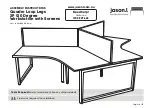
RP0177-2000
NACE International
i
_______________________________________________________________________
Foreword
This standard recommended practice presents guidelines and procedures for use during design,
construction, operation, and maintenance of metallic structures and corrosion control systems
used to mitigate the effects of lightning and overhead alternating current (AC) power transmission
systems. This standard is not intended to supersede or replace existing electrical safety
standards. As shared right-of-way and utility corridor practices become more common, AC
influence on adjacent metallic structures has greater significance and personnel safety becomes
of greater concern. This standard addresses problems primarily caused by proximity of metallic
structures to AC-powered transmission systems.
The hazards of lightning effects and alternating current effects on aboveground pipelines, while
strung along the right-of-way prior to installation in the ground, is of particular importance to
pipeline construction crews. The effects of overhead AC power lines on buried pipelines is of
particular concern to operators of aboveground appurtenances and cathodic protection testers, as
well as maintenance personnel working on the pipeline.
Some controversy arose in the 1995 issue of this standard regarding the shock hazard stated in
Section 5, Paragraph 5.2.1.1 and elsewhere in this standard. The reason for a more conservative
value is that early work by George Bodier at Columbia University and by other investigators has
shown that the average hand-to-hand or hand-to-foot resistance for an adult male human body
can range between 600 ohms and 10,000 ohms.
1
A reasonable safe value for the purpose of
estimating body currents is 1,500 ohms hand-to-hand or hand-to-foot. In other work by K.S.
Gelges and C.F. Dalziel on muscular contraction, the inability to release contact would occur in
the range of 6 to 20 milliamperes for adult males.
2
Ten milliamperes hand-to-hand or hand-to-
foot is generally established as the absolute maximum safe let-go current. Conservative design
would use an even lower value. Fifteen volts AC impressed across a 1,500-ohm load would yield
a current flow of 10 milliamperes; thus the criterion within this standard is set at 15 volts. Prudent
design would suggest an even lower value under certain circumstances.
This standard was originally published in July 1977 and was technically revised in 1983 and 1995.
NACE International continues to recognize the need for a standard on this subject. Future
development and field experience should provide additional information, procedures, and devices
for Specific Technology Group (STG) 05 to consider in future revisions of this standard. This
edition of the standard was reaffirmed by Unit Committee T-10B on Interference Problems. The
NACE technical committee structure changed in 2000, following the reaffirmation of this standard.
This standard is issued in 2000 by NACE International under the auspices of STG 05 on
Cathodic/Anodic Protection.
In NACE standard, the terms
shall, must, should and may are used in accordance with the
definitions of these terms in the
NACE Publications Style Manual, 4th ed., Paragraph 7.4.1.9.
Shall and must are used to state mandatory requirements. Should is used that which is
considered good and is recommended but is not absolutely mandatory.
May is used to state that
which is considered optional.
_______________________________________________________________________
Summary of Contents for CP 1
Page 1: ...CP 1 Cathodic Protection Tester Course Manual February 2005 NACE International 2000 ...
Page 265: ......
Page 266: ......
Page 267: ......
Page 268: ......
Page 301: ...RP0169 2002 32 NACE International ISBN 1 57590 035 1 ...
Page 535: ...TM0101 2001 24 NACE International ISBN 1 57590 137 4 ...
















































